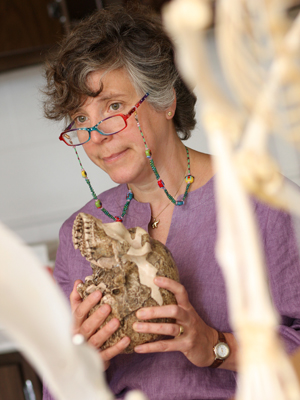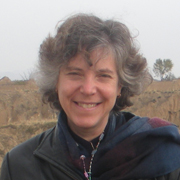Neandertals and modern humans roamed the earth at the same time. Why has Homo sapiens survived while Neandertals are nowhere to be found? What made us special?
Rachel Caspari thinks a shift toward living longer gave humans a leg up. Caspari, an anthropologist at Central Michigan University, and her colleague Sang-Hee Lee used prehistoric dental remains to deduce that grandparents became common rather late in human evolution — only about 30,000 years ago. Before, few humans or Neandertals survived their hard-knocks lifestyle to ever see their grandchildren. A scant number made it past age 30, which we now consider the prime of life.
Caspari believes the grandparent explosion also led to a burst of art and style. Long life, she argues, is what gives us our humanness.
But not all was happily ever after. Living longer has come with costs; just look at the hospital bill of an elderly family member. Many of these problems arise because humans were not evolutionarily built for perfection. Design trade-offs slipped in as human ancestors evolved from walking on all fours to an upright gait. With old age, the frays in the patchwork construction of Homo sapiens become more apparent. They are what Caspari calls "the scars of human evolution," the name of the symposium in which she spoke at the February 2013 meeting of the American Association for the Advancement in Science in Boston. Afterward, SciCom’s Ryder Diaz sat down with Caspari to chat about what makes us human, for better or worse.
How did you get interested in longevity?
Two things are really interesting about modern humans. One is that we live a long time. The second is, we have no races. How is it that we are this widespread species, we live all over the world, yet we don’t have the same population divisions that you see in bears or grey wolves or deer?
I started thinking about longevity because, in some ways, it’s easier to study that in the past. There’s this huge increase in adult survivorship that is associated with the Upper Paleolithic [50,000 to 10,000 years ago], and maybe that is exactly what makes us human.
You reasoned that a shift in people living longer began around 30,000 years ago. How did looking at worn-down dental fossils help?
It’s based on the Miles method, which calculates “wear rates” by looking at the rate of [tooth] wear in juveniles. We know that the first molar comes in at about age six and the second molar comes in at about age 12. There's six years of wear on that first molar, and we can extrapolate back to other teeth.
We used this method to put people into two samples: older adults and younger. In Neandertals, only 4 people out of 10 were living to be older adults. [For humans] in the Upper Paleolithic, we saw a shift in that pattern: for every 10 younger adults, there were 20 older adults.
For your 2004 PNAS paper, you and Sang-Hee Lee examined teeth from almost 800 people. Is that enough to make a convincing case?
It's what we have. It's a tiny sample if you were looking at living people, but it's a huge sample when you're looking at fossils.
Are there limitations to the teeth-wear technique?
There are tons of limitations, which is why we use broad categories [of young and old]. As teeth get very worn, it gets very difficult to assess age. We didn't even try to put actual ages on the teeth.
You’ve presented new methods at meetings that you think will be able to give more precise ages.
There are changes in the internal structure of teeth that happen with age. One of them has to do with the occlusion of dentin tubules. [Dentin is the inner part of the tooth covered by enamel.] Another thing that happens is this buildup of secondary dentin in the pulp chamber, which has traditionally been analyzed by sectioning and destroying the teeth. You can’t do that with a fossil.
Excuse me, can I cut open your museum specimen?
Exactly. It’s just not going to happen. I was thinking of ways we could look at some of these criteria non-destructively. MicroCT [a high-resolution, three-dimensional CAT scan] turned out to be a really useful tool.
"Many people thought the modern humans were the smart ones, and the poor old schlubby Neandertals couldn’t do it. I never thought that was true."
Were you able to confirm the ratios you found using teeth wear with microCTs?
Yes.
And you use teeth because they hold up better?
Right. They’re durable, and that’s what most of the fossil record is. We’ve got a lot of teeth.
Why did people start living longer?
Maybe it had to do with some kind of subsistence strategy that people tried, or a social experiment of some sort. Maybe just a few populations took better care of older people. They were able to have more offspring because older folks take care of their grandchildren, and younger adults can forage [more]. So, you’re going to have this increase in population.
Is there a way to test those hypotheses?
I don't see how. What we can see is that there's a larger number of older adults in the [fossil] record. But exactly why, that's difficult to know.
What are a couple of the benefits, evolutionarily, that came with longer life?
Once you have larger populations, you have more people to innovate. I think you need to have a critical mass in populations for people to come up with great ideas. You can inspire an artist and give an artist time, for instance, to make beautiful little Venus figurines or to draw pictures of beautiful bison on cave walls.
People have interpreted a lot of stylized things, like jewelry and body ornamentation and probably clothes and hats — which, of course, don’t preserve — as signals to other people about what group you belong to. People have suggested that the origin of style, which is what we see in the Upper Paleolithic, comes into play because people are sending messages about their group identity.
Was this a break from the way researchers had previously thought about the origin of art — especially with humans and brain size?
Many people thought of it as a phylogenetic thing [a new species that evolved with different traits]: you have modern humans [and] they replace Neandertals. The modern humans were the smart ones, so they had the cognitive capacity to make this beautiful art. The poor old schlubby Neandertals couldn’t do it. I never thought that was true.
Why not?
Because Neandertals have big brains. And I thought there was evidence of interbreeding between Neandertals and modern humans. You don’t see modern humans anatomically appear and then suddenly see a big shift in behavior. It’s just in the last 30,000 years or so that you see this artistic explosion.
This relationship seems like a difficult thing to test.
It is. But there are people who are modeling these parameters, which gives it a little more support than just a guess. The only thing we've been able to do is show that there's a coincidence between an increase in the number of older adults and a change you see in the archeological record.
Has the role of older people changed in society?
Older people are probably listened to more than ever before in some realms. But they’re also discarded. Old people give you the experience to handle challenges that you might not have experienced before. But now you have Google.
Ha! Google is the new older person?
No, I don’t think so. We clearly can’t get our social relationships and our own cultural values from Google. But Google does help.
Your own grandmother and great-grandmother lived to be almost 100 years old.
Yeah, keep your fingers crossed.
How did they influence your life?
I always thought it was amazing that I could talk to my grandmother about the first time she saw a car, or her relationships with other relatives who were alive before the Civil War. I was able to put stories together with all these figures, and I could look at them on a family tree.
So you have your own family history, and then you have this broader history.
It’s that ancestral history that ties you to those people in the here and now and makes those social relationships. Up until the last hundred years, that’s the way people thought about themselves. “Who are your people?” My grandmother used to say that.
We’ve talked about the good parts of longevity, but there’s also a downside.
There are all sorts of horrible things. We have problems associated with the tradeoffs we’ve made in so many different areas, like orthopedic problems associated with bipedalism. As you get older, these things get worse. You’re not having babies when you’re older, but those pelvic floor muscles get weakened because of childbirth and because of years of being a biped. These are byproducts of longevity.
What about degenerative diseases?
They’re killing you because other things haven’t. Things that never would have plagued our Paleolithic ancestors are plaguing people today because they’re living longer.
One of the first things you said was that there are no races. How do anthropologists think about this?
When most people think about social races, they think about their idea of race they grew up with. It has this implicit biological meaning that people don’t really try to untangle. Humans are unique. There are genetic connections between everybody, and there have been for a really long time.
Right. There aren't a lot of genetic differences between you and me. But in the past centuries, there was a lot of scientific inquiry about difference.
Oh, absolutely. Science is a human activity. And there’s nothing more dangerous than the science of human variation because it can be used to justify all sorts of inequality. [In the past, scientists] looked at skeletal metrics to say, "Aha! These people are really different." They fundamentally said we have to assume that different racial groups are effectively members of different species. This was a widely held belief.
How do you square this interest with your interest in longevity?
My big question is what makes modern humans human. It has to do with population structure — with demography. In demography, you find the real interplay between biology and culture.
So, why understand the process?
Why? Oh, I don’t know, I’m just curious. I got into this field because I was really interested in constructing the life ways of our ancestors, and nothing influences that more than demography: who was on the ground.
Fundamentally, your question is why should we care about the evolution of humans? I think partially for the same reason we’re interested in our own family histories: It helps connect us to the rest of the world. It helps us see what makes us human and what we all share in common. It helps us understand where we’ve come from, and perhaps where we’re going.
____________________
Ryder Diaz, a graduate student in the Science Communication Program at UC Santa Cruz, earned his bachelor's degrees in metropolitan studies and gender and sexuality studies at New York University and his master's degree in population biology at UC Davis. At UCSC, he has worked as a reporting intern at the Salinas Californian, the San Jose Mercury News, and Inside Science News Service (American Institute of Physics). This summer, he'll work for KQED public radio in San Francisco through the Kaiser Family Foundation health reporting internship program.
© 2013 Ryder Diaz


